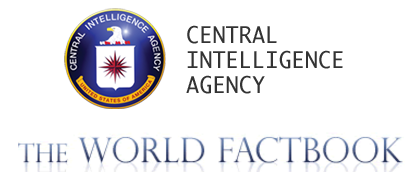Online Sources
 CIA: The World Factbook - Central America and the CaribbeanAvailable online (free).
CIA: The World Factbook - Central America and the CaribbeanAvailable online (free).
The World Factbook provides information on the history, people, government, economy, geography, communications, transportation, military, and transnational issues for 267 world entities. Our Reference tab includes: maps of the major world regions, as well as Flags of the World, a Physical Map of the World, a Political Map of the World, and a Standard Time Zones of the World map.
IWGIA - International Work Group for Indigenous Affairs

- IWGIA - International Work Group for Indigenous AffairsIWGIA - International Work Group for Indigenous Affairs - is a global human rights organisation dedicated to promoting, protecting and defending indigenous peoples’ rights. (IWGIA)
- IWGIA YearbookThe Indigenous World is a one-of-a-kind documentation tool, that offers a comprehensive yearly overview of the developments indigenous peoples experience around the world. The book also serves as inspiration to raise global awareness of the rights of indigenous peoples, their struggles, their worldviews and their resilience. (IWGIA)
World Bank
- World Bank Data by countryChose from: Country at a Glance tables: two pages of key indicators tracing the trends in social and economic development from the last three decades; Data Profile tables: data profiles available here are drawn from the World Development Indicators database. The profiles cover the 208 countries (184 World Bank members and 24 other economies with populations of more than 30,000) and 18 country groups reported on in the World Development Indicators; EdStats: short for Education Statistics, is a comprehensive education statistics database; GenderStats: a database of gender statistics, showing summary gender indicators, basic demographic data, population dynamics, labor force structure, and education and health statistics; HNPStats: short for Health, Nutrition, and Population Statistics offers country data sheets showing summary indicators for health status, health determinants, and health finance.
- Global Economic Monitor (GEM)GEM is the World Bank's portal for analysis of current economic trends, and economic and financial indicators. GEM features up-to-date analysis on global economic conditions, including a daily brief and event-driven focus reports, direct access to high-frequency datasets via Quick Query, forecasts for commodity prices and main macroeconomic indicators for over 130 countries.
Inter-American Dialogue - think tank

The Inter-American Dialogue is the leading U.S. center for policy analysis, exchange, and communication on issues in Western Hemisphere affairs. The Dialogue brings together public and private leaders from across the Americas to address hemispheric problems and opportunities. Together they seek to build cooperation among Western Hemisphere nations and advance a regional agenda of democratic governance, social equity, and economic growth.
- Latin America AdvisorToday the group is comprised of approximately thirty experts from the Andean region as well as key policymakers from Argentina, Brazil, Chile, and Mexico.
- Caribbean RegionThe Dialogue’s Caribbean Region Program focuses on Cuba, Haiti, and the Anglophone Caribbean.
Election Information
Administration and Cost of Elections Project - This website is sponsored by the International Foundation for Election Systems, International IDEA, and the United Nations. It attempts "to provide a global electronic information resource that explores alternatives in election administration, functions, processes and costs."
International Foundation for Electoral Systems - The International Foundation for Electoral Systems provides professional advice and technical assistance in promoting democracy and serves as an information clearinghouse on democratic development. Its Election Guide provides international election dates, results, and information, 1998-2011.
LANIC Electoral Observatory - Provides extensive coverage of presidential and legislative elections in Latin America; from the Latin American Network Information Center (LANIC) at the University of Texas. Time period: 1998-2008.
Latin American Election Statistics: A Guide to Sources - This electronic resource consists of a series of volumes on selected Latin American countries that provide chronologies of elections since independence at the municipal, state, and federal levels and list sources of statistics for each election as identified. The statistics themselves are not reproduced here except occasionally for national-level results of presidential elections, seats won in congressional elections, or numbers of municipalities won by specific parties. No attempt was made to evaluate the accuracy of the statistics, and multiple sources are listed as available to provide for comparison. The focus is on identifying sources of electoral statistics. Also included is information on events affecting election outcomes; on the emergence and development of political parties; on electoral code changes; and on the roles of women, indigenous populations, and religious organizations in each country's electoral politics.
Lijphart Elections Archive, University of California, San Diego - A research collection of district level election results for approximately 350 national legislative elections in 26 countries. The objective of the Archive is to systematically collect election statistics in as much detail as possible, including, as a minimum, the results at the level of the individual election districts in which votes are converted into seats.
Voter Turnout from 1945 to Date: a Global Report on Political Participation- from the International Institute for Democracy and Electoral Assistance (IDEA)
- Voter Turnout DatabaseThe Voter Turnout Database is the best resource for a wide array of statistics on voter turnout from around the world. It contains the most comprehensive global collection of voter turnout statistics from presidential and parliamentary elections since 1945.
(International Institute for Democracy and Electoral Assistance (International IDEA)) - International Encyclopedia of ElectionsExamination of elections worldwide. (2000)
Country Profiles
- USAID - HaitiUSAID has worked in Haiti for approximately 50 years, helping to mitigate the impact of natural disasters and periods of political instability, while increasing long-term economic growth and security.
Full profiles provide an instant guide to history, politics and economic background of countries. They also include audio and video clips from the BBC archives.
Country Indicators for Foreign Policy
The CIFP database includes measures of domestic armed conflict, governance and political instability, militarization, religious and ethnic diversity, demographic stress, economic performance, human development, environmental stress, and international linkages, in the form of over one hundred performance indicators for 196 countries, spanning fifteen years (1985 to 2000) for most indicators. These indicators are drawn from a variety of open sources.
Country Studies/Area Handbook Series
The Country Studies Series presents a description and analysis of the historical setting and the social, economic, political, and national security systems and institutions of countries throughout the world and examines the interrelationships of those systems and the ways they are shaped by cultural factors. At present, 101 countries and regions are covered, published between 1988 and 1998. Check CLIO under "[country name] a country study" for location of print versions.
"The profiles offer reasonably current country information independent of the existence of a recently published Country Study and will be updated annually or more frequently as events warrant." Eldis Country Profiles Links to hundreds of authoritative sites for developing countries, in the areas of: agriculture, environment, poverty, education, gender, health & population, governance, trade, economics, aid, microcredit, and security.
The Food and Agriculture Organization for the United Nations and its 183 members highlight information as one of the priority areas in fighting hunger and achieving food security. The FAO Country Profiles and Mapping Information System is a pioneering information retrieval tool which groups the organization's vast archive of information on its global activities in agriculture and development in a single area and catalogues it exclusively by country.
Very detailed links for every country.
The profiles compiled by the International Planned Parenthood Federation include brief background information, sections on sexual & reproductive health and family planning services in the country, and statistics on population, fertility and contraception, mortality, health, and education & employment.
International Crisis Group: Reports by Country
Not all countries are represented, just those which are involved or potentially involved in conflict situations.
International Monetary Fund Country Information
IMF operations — which involve surveillance, financial assistance, and technical assistance — have developed to meet the changing needs of its 184 member countries in an evolving world economy.
Links only to documents with an individual country focus. Includes both member and non-member economies, but with more information for member countries, especially a statistical profile with over 100 indicators. For links to OECD publications which cover all countries, see OECD iLibrary below.
Social Security Web Sites Around the World and Social Security in Other Countries
Brief descriptions of programs for each country, from the U.S. Social Security Administration
UNESCO Institute for Statistics Country Profiles
Country profiles feature key statistics and indicators on education, science and technology, and culture and communication on a country-by-country or regional basis.
International Statistics - Start here
World Development Indicators (WDI)
World Development Indicators (WDI) is the primary World Bank collection of development indicators, compiled from officially recognized international sources. It presents the most current and accurate global development data available, and includes national, regional and global estimates. UN DataA portal that retrieves data series from the United Nations System and other international organizations. Sources include FAO, ILO, WHO, and the Human Development Report. Country profiles and glossaries are also provided. Freely accessible to the public via the Internet.
UN DataA portal that retrieves data series from the United Nations System and other international organizations. Sources include FAO, ILO, WHO, and the Human Development Report. Country profiles and glossaries are also provided. Freely accessible to the public via the Internet.World Health Organization - Country Profiles
Includes basic vital and health statistics, health expenditures, provision/coverage, health system organization and regulation, summary measures, country-specific conditions, and human resources.
- World Population Data(PRB - Population Reference Bureau)
View data on global, regional, or country maps or tables. - 2018 World Population Data SheetPRB’s World Population Data Sheet, has been produced annually since its debut in 1962. This and other PRB data sheets are used by thousands of people worldwide as a ready reference for comparing key demographic and health indicators by country and region, and for population projections and analytical graphics that bring key data insights into focus.
Statistics & More
Country Indicators for Foreign Policy
The CIFP database includes measures of domestic armed conflict, governance and political instability, militarization, religious and ethnic diversity, demographic stress, economic performance, human development, environmental stress, and international linkages, in the form of over one hundred performance indicators for 196 countries, spanning fifteen years (1985 to 2000) for most indicators. These indicators are drawn from a variety of open sources.
GeoHive provides demographic and economic statistics for all countries, at both the national and sub-national levels. The site is divided into four main parts. One dealing with the whole world and its regions, a second with the major regions, a third with all major countries separately and a fourth with rankings (the most, largest, longest, wealthiest, etc.).
From Michigan State University, this web-portal connects international business professionals. Contains a section on "Country Insights" with statistical data for 201 countries around the world. In addition to statistics, historical, economic, and political conditions are available.
Allows users to generate graphs based on numerical data extracted from numerous sources. All sources are documented.
People in the Balance: Population and Natural Resources at the Turn of the Millenium
The focus here is on population, water, land, forests, fisheries,CO2, and biodiversity, with sections on each. Data is also provided for each country, both in tabular form and CSV data sets.